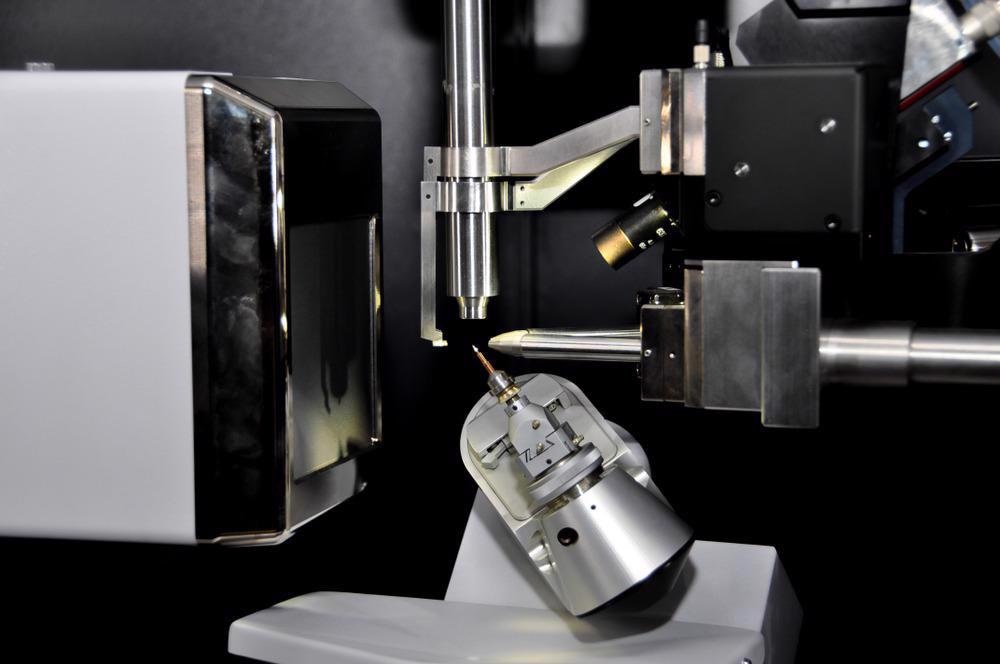
Image Credit: Isuaneye/Shutterstock/com
Particle size analysis is crucial to quality control and product development in a number of key industries including aerosols, construction, food and beverage, paint and coatings, and pharmaceuticals. The particle size of products produced within these industries can impact the product’s efficacy, properties, and safety.
For this reason, reliable, accessible, and accurate methods of particle size analysis that are non-destructive are in high demand. Here, we discuss the method of particle size analysis by X-ray diffraction.
What is X-ray Diffraction?
X-ray diffraction by crystals was discovered in 1912 by Max Von Laue and his team of scientists at the Institute of Theoretical Physics at the University of Munich, Germany. Since then, the method which can produce fine-grain detail about a material’s chemical composition, crystallographic structure, and physical properties has been adopted across a range of applications in the fields of geology, environmental science, material science, engineering and biology.
The non-destructive technique is used to analyze the atomic or molecular structure of a sample. It best works with materials that are at least partly constructed of crystalline. Often, materials assessed by X-ray diffraction are ground into a powder to achieve a uniform state before they are investigated. For this reason, X-ray diffraction is often known as X-ray powder diffraction.
To give a basic description of the process, X-ray diffraction is when light is exposed to a material and the degree to which it bends as it moves around the edge of an object or meets an obstacle or aperture. Scientists are able to measure the degree of this light bend which is dependent on the wavelength and nature of the obstacle or aperture.
Below, we outline how X-ray diffraction has been developed to allow scientists to measure particle size at the scale of the nanometer, a technique that is vastly useful across industries and disciplines.
The Scherrer Equation
A formula known as the Scherrer equation is used in X-ray diffraction and crystallography to link the broadening peak of a material’s diffraction pattern with the size of its sub-micrometer crystallites. The formula, named after Swiss physicist Paul Scherrer, is used to measure the size of the crystals in a powdered sample.
The method of particle size analysis by X-ray diffraction using the Scherrer equation is fairly simple. To look at a graph plotting the X-ray diffraction pattern of a sample, it is likely to see a broadening of the waves which represent the diffraction. This broadening relates to particle size.
If a graphical depiction of X-ray diffraction of powdered particles were compared with the diffraction of that of the material in its bulk form, it would be possible to clearly note the well-resolved Ka2 line in the bulk sample, but not in the particle sample. The width of the peaks within the X-ray diffraction pattern is described by ‘b’, which equates to the full width at half the peak’s maximum intensity.
Instrumental contribution is used to correct for the value of b (in radians) to allow it to then be substituted into Scherrer’s equation. The equation can then compute the average particle size, however, this method is limited. It cannot be used to assess particles larger than around 0.1 to 0.2 μm, and it can also not be used to assess particle size in samples where the material has been under strain.
Accounting for Stress
Scherrer’s method is useful and simple, however, it cannot be used when the material to be assessed has been under stress. This is because stress also causes broadening of the diffraction peaks, and, therefore, the equation cannot be used to draw out the broadening that is only related to particle size and not due to stress.
In these instances, a more complex method is used to separate the contributions of stress and particle size. Most often, methods are used that leverage the fact that broadening from stress and broadening from particle size have unique angular relationships. Size broadening due to particle size has a 1/cos(Q) relationship and broadening due to strain (stress) has a tan(Q) function relationship, where Q is the diffraction angle.
Finally, broadening due to the instrument must be controlled for in order to ensure that instrumental interference is not included in the final measurement. Using a least-squares method, the broadening observed over numerous peaks is used to calculate the average particle size of the sample.
Conclusion
Overall, particle size can be reliably measured using different methodologies of X-ray diffraction, dependent on the situation. The non-destructive method can be used by the multiple industries that depend on particle size analysis for quality control.
References and Further Reading
Eckert, M., 2012. Max von Laue and the discovery of X-ray diffraction in 1912. Annalen der Physik, 524(5), pp.A83-A85. https://onlinelibrary.wiley.com/doi/pdf/10.1002/andp.201200724
Particle Size and Strain Analysis by X-Ray Diffraction. H & M Analytical Services. Available at: https://h-and-m-analytical.com/wp/
Usage of Scherrer’s formula in X-ray diffraction analysis of size distribution in systems of monocrystalline nanoparticles. Valério, A., and Sérgio, L. M. Cornell University. Available at: https://arxiv.org/pdf/1911.00701.pdf
Disclaimer: The views expressed here are those of the author expressed in their private capacity and do not necessarily represent the views of AZoM.com Limited T/A AZoNetwork the owner and operator of this website. This disclaimer forms part of the Terms and conditions of use of this website.